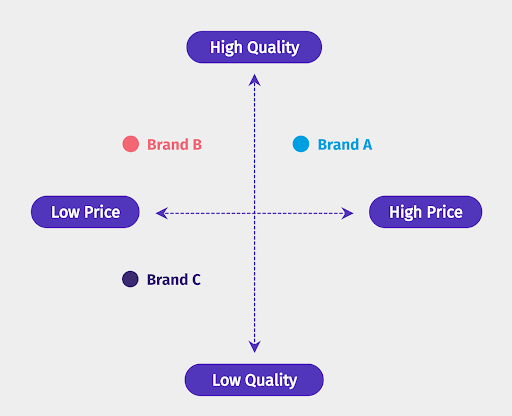Brand Positioning Strategies
Positioning is an essential element for every marketing strategy for both customers as well as B2B (Business to Business). ‘Positioning’ means providing value to the customers in a unique way. Successful branding provides benefits like enhanced customer loyalty, improved brand image and a relatable identity. Brand positioning is a process to put your brand into the minds of the customers and supporters.

Understanding Brand positioning:
Brand positioning is a marketing strategy used to set your business to stand differently than others. It is the process of positioning your brand in the mind of the customer. A brand is said to have an effective brand positioning when it is said to be favourable and credible to the customer.

Importance of brand positioning:
Brand positioning is important to create a reputation and an image of your brand. It helps a company to differentiate itself from its competitors. This differentiation results in enhanced brand awareness.
Let us look at some benefits of brand positioning:
- Create an audience targeted messaging – A successful brand positioning requires you to first find your targeted audience and then understand them. Also, see how they perceive your brand and your competitors. This way you can create a well personalised and targeted campaign which your customers would love to respond to.
- Be a problem solver – A well positioned brand always focuses on solving problems of the targeted customers. The more answerable your brand is to the customers, the more effective you will be able to communicate your value and your brand story.
- Be different – You have to stand out of your competitors to grab your customer’s attention. Why would users choose you over other brands? Differentiation is the answer to such questions. Brand positioning allows you to find your own value in the market and then communicate such uniqueness to the customers so that they find it easier to differentiate you from other competitors.
- Research the market prices and choose accordingly – Your product prices should be competitive and as per the current market scenario. Brand positioning helps you to identify your competitors and their pricing strategies. It also helps to justify your chosen pricing strategy.
- Be a creative decision-maker – Knowing how your customers perceive you will guide you to create more focused campaigns. When you have many competitors in your niche, it’s a bit tough to come up with unique ideas. Creating a positioning strategy will help you find a concentrated niche and come up with creative ideas to achieve your business goals.
How to build a powerful brand positioning?
- STEP 1: Analyse your customer’s needs, your brand’s capabilities and research your competitor’s brand positioning strategies.
- STEP 2: Choose a positioning statement which will link with your customers, will be deliverable and which will be different from that of your competitor. Try not to choose generic words for your statement.
- STEP 3: Reflect this brand positioning in each of your marketing activities, like packaging design, product/ service design, brand personality and others.
Perceptual brand mapping:

Perceptual/ positional mapping is a virtual representation of where your brand, its products/ services stand among its competitors. It is a type of competitive analysis framework consisting of two key elements- price and quality. After choosing the attribute best for you, plot the brand- its products/ services to see how they are positioned among these attributes.
Perceptual brand mapping uses inputs by the customers to understand your brand- its products/ services from the customer point of view.
Carefully studying the above map, you can imagine it to be the mind of the customer. Each of the three brands A, B and C occupy a unique position on the map.
Let us understand the map in short. In the map, Brand A is perceived to offer higher quality than that of Brand C. Brand B also offers higher quality than brand C but has a lower price than Brand A.
Your own brand should always strive to position itself as favourable, unique and credible. The ultimate success of your brand will thus be determined by how it positions itself in these three domains.
Brand positioning examples:

Many companies have reached heights by building a strong positioning strategy that rivals the rest. Let us look at some examples of Brand Positioning statements.
- Dabur – Well established brand in the cosmetics and food industry. They have established their brand positioning by providing products derived from natural and exotic sources. The motive of the brand is to introduce its consumers with its Ayurvedic legacy in a modern and contemporary outlook.

- Bumble vs Tinder – Bumble was positioned as an app designed for encouraging women empowerment. It mainly focussed on bettering the female user experience. It also offers dating, the user can find friendship and professional connections within its platform. On the other hand, Tinder focuses on fleeting connections. Bumble had a different strategy, i.e., it gave women to be the initiator and not the men. Tinder on the other hand is leader based.
- SBI – Well known traditional bank of India. It has built its positioning as a modern and progressive bank ready to meet the needs of the tech-savvy Indians and as the best people friendly bank.
- Maggi – A product of Nestle, Maggi has made its position in the snack category. Along with their punchline, they positioned their brand in the consumers mind as “Fast to cook! Good to eat!”.
- Honda – It positions its product with its competitors Toyota, Ford, etc. as a “value of money” vehicle which provides high quality, reliable performance and better fuel efficiency at competitive prices. Honda has positioned itself as a Japanese manufacturer with an Indian heart where cars are very competitive for fuel efficiency, engineered quality and long term performance.
- Amazon India – Amazon has positioned itself as a “one-stop shopping destination for all”, where people can purchase a wide range of products.
- Patanjali – The brand’s slogan is “Prakriti ka Aashirwaad” which means “Blessings of Nature”. Patanjali has positioned itself as “natural products available at affordable prices”. The marketing strategy of Patanjali uses value based positioning strategies to establish a sense of trust of customers.
- Spotify vs Apple Music – Spotify is known for its high personalisation and Apple Music is well known for providing a premium range of songs. Spotify uses a price based strategy and Apple uses a quality based approach for marketing.
- Google Meet vs Zoom – Virtual connection has become the new normal in today’s digital generation. The pandemic has seen tools like Google Meet and Zoom come up as new tools for online connectivities.
Brand positioning strategies to stand out from your competitors:
- Define your present position – You should first assess where you currently stand in the customer’s mind. This can be achieved through many ways. One such method is to conduct surveys and collect feedback from the customers to know how they perceive your brand. Then you can visualise your findings and share them with your co-workers to know your current brand positioning.
Another method is to analyse your own marketing and sales strategies, by looking at your best-selling products, customer complaints and your most successful marketing campaigns. You can also practise social listening to know your current brand positioning, using tools to track your social conversations and social activities. This information can give you knowledge about how your customers perceive your brand.
- Identify your target audience – It is a crucial step in effectively positioning your brand in the market. This can help you narrow down your target audience range and thus help you focus on their needs more precisely. This way you can know to whom you are selling your product/ services. Sharing such information with your team can help you build a strong marketing plan.
- Know your competitors – Understanding the strength and weakness of your competitors will help you identify a gap in the market where you can effectively position your brand. Try to collect data on your competitors and know how they are positioning their brand in the market. You can check out their social media accounts, read their blogs and analyse their content across various media. Find out their most popular products and what type of graphics they use in marketing their products. Social listening can also give you an insight about your competitors. Study about the customer complaints of your competitors.

- Find out your strength and weakness – Study your organisation in detail and identify where you are good at and where you are lacking. This can be done by conducting a SWOT analysis. Conducting a SWOT analysis will help you create the right type of brand positioning.

- Find your uniqueness – Craft your unique selling point and value positioning, i.e. find out what major things makes you different from your competitors. On finding your true call, sum it up into a mission/ vision/ core values of your brand.
For instance, you run a restaurant. Your strength is good food quality but your weakness is the higher price of your food products as you use high-quality ingredients. So to stand out from your competitors, you can capitalise on your strength and position yourself as a high-quality brand for those who prefer taste over price. Here your competitive advantage would be that you will offer your customers an unforgettable taste which you won’t find anywhere else.
- Jot down your brand positioning statement – Once you collect data about your brand and the market, you can write it down as a brand positioning statement. A brand positioning statement is basically a one or more than a one-word statement which sums up who your target customer is, what your product/ service is all about and the benefits your brand offers.
- Message consistently – Once you have done all your homework, it is time for proper execution. If your brand positioning lacks communication, then your brand positioning will not be fruitful. You should then visualise your customer’s journey and jot down all the touchpoints, which may include your website, social media accounts, emails, paid ads, etc.
Your messaging should be consistent and should be around your customer touchpoints and should be linked with your brand positioning. For this, you can use bright colours, tone of voice and attractive images. Brand positioning is not just limited to the user or customer touchpoints. It should also reflect in your business strategies. Every communication you make should be consistent with your brand positioning and brand identity.
- Evaluate your brand positioning – You have to constantly monitor and evaluate your positioning strategies. Keep track of your online activities, conduct surveys and gather real-time customer feedback.
- Quality positioning – It can be used along with your other brand marketing strategies. Customers want to know whether your products are reliable, durable and worth buying.
- Celebrity driven positioning – Popular personalities and advertising go hand-in-hand. Every customer likes to see familiar faces in their ads.

Conclusion
For efficient brand positioning in the customer’s mind and in the market, you have to do something different from your competitors. This way you will gain a competitive advantage. A unique brand positioning strategy is very essential to create a statement and grab your audience’s attention, thus successfully growing your brand.
FAQs Related to Brand Positioning Strategies:
-
What is brand positioning?
Brand positioning is a marketing strategy used to set your business to stand differently than others. It is the process of positioning your brand in the mind of the customer.
-
What are the examples of brand positioning?
1. Dabur
2. Bumble vs Tinder
3. SBI
4. Maggi
5. Honda
6. Amazon India
7. Patanjali
8. Spotify vs Apple Music
9. Google Meet vs Zoom -
What are brand positioning strategies?
1. Define your present position
2. Identify your target audience
3. Know your competitors
4. Find out your weakness and strength
5. Find your uniqueness
6. Jot down your brand positioning statement
7. Message consistently
8. Evaluate your brand positioning
9. Quality positioning
10. Celebrity driven positioning



2 thoughts on “5+ Powerful Brand Positioning Strategies to Stand Out From Your Competitors”
Comments are closed.